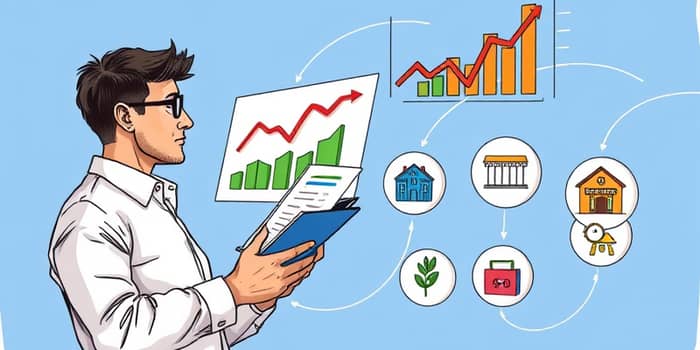
Commercial lending fuels business growth but carries complex risks that vary by industry. Understanding these nuances is crucial for building a resilient loan portfolio.
Commercial lending provides capital for business expansion, new projects, and cash flow management through loans, lines of credit, and leases. It is a cornerstone for economic development, empowering companies to invest in infrastructure, innovate products, and hire talent.
However, this vital function involves diverse and significant risks that can impact both lenders and borrowers. Recognizing and quantifying these exposures ensures institutions can support growth while maintaining financial stability.
Effective risk assessment begins with identifying the fundamental categories of exposure. Each risk type manifests differently depending on economic conditions and the specific sector financed.
Beyond these categories, institutions must also consider strategic, fair lending, and third-party risks. Each risk dimension requires tailored evaluation techniques and monitoring protocols.
Sectors diverge in their vulnerability to macroeconomic forces, regulatory environments, and operational challenges. Assessing these distinctions helps lenders allocate resources and set appropriate limits.
Accurate measurement of exposures demands a structured approach. Institutions increasingly leverage data-driven models alongside traditional financial analysis.
Lenders must navigate a complex web of laws designed to protect borrowers and ensure market integrity. In the United States, frameworks like the Equal Credit Opportunity Act and the Fair Housing Act require rigorous oversight.
Regular fair lending risk assessments should include data collection on applicant demographics, analysis of model inputs, and corrective action plans for any disparities detected. Maintaining detailed documentation of methodologies and decisions fosters transparency and regulatory trust.
Recent 2024–2025 data reveal that post-pandemic shifts in market behavior continue shaping sector risk profiles.
Commercial real estate nonaccrual and charge-off ratios remain below levels seen during the 2008 financial crisis, despite stress in office and retail segments. Consumer lending asset quality has held steady, though income growth has moderated. Growth in private credit underscores demand for alternative financing, while warranting close monitoring for concentration risk.
These trends highlight the necessity of real-time risk identification and monitoring to adapt to evolving conditions and protect portfolio health.
Mitigating sector-specific risks involves setting guardrails, deploying technology, and maintaining vigilance.
Institutions that embrace these measures alongside robust governance build resilience that sustains credit availability through market cycles.
Assessing sector-specific risks in commercial lending is both an art and a science. By combining robust internal processes and controls with advanced analytics, lenders can strike a balance between supporting borrower growth and safeguarding financial stability.
A well-structured risk management framework equips institutions to anticipate challenges, seize opportunities, and deliver capital where it drives innovation and prosperity. In a rapidly changing economic landscape, a proactive and disciplined approach to sector risk assessment is the key to sustainable success.
References













